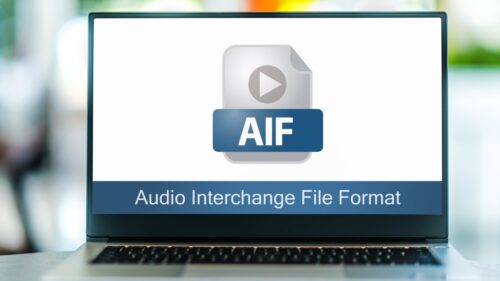Audio file formats are the invisible tunnels of sound – transporting music melodies, film dialogue, and podcast narratives to international audiences. Common audio file formats have unique features and benefits, from editing a film to extracting audio from video. To keep up with evolving technology, creators, streaming services, and broadcasters must learn to pivot between each one. The key is knowing which audio format is best for your AV projects.
At Voice123, the home of uniquely talented voice over artists, we understand the impact of audio formats on sound quality. Here, we’ll explore audio file types, how to choose the best audio format, and the most common audio file formats for AV projects.
Are you ready to make sound waves in the realm of audio formats?
What are audio file formats?

Audio file formats are types of digital files that store and encode audio data, such as MP3 (MPEG-1 audio layer 3), WAV (waveform audio file format), AAC (advanced audio coding), FLAC (free lossless audio codec), and AIFF (audio interchange file format). Each file is compatible and accessible on different devices like computers, phones, or streaming media players. Audio file types are like packaging materials for audio data—some are lightweight and convenient but have reduced quality, while others provide maximum quality with heavier storage space. Understanding each file’s specifications will help you choose the best audio format for your AV project.
10 Common audio file formats
- MP3 (MPEG-1 audio layer 3) reduces the file size instead of quality. So it’s great for creating playlists, sharing music online or on media players, and creating musical interludes for presentations or conferences.
- WAV (waveform audio file format) maintains high-quality, uncompressed audio for music production or editing. A music producer can use it to record studio vocals with high audio fidelity.
- AAC (advanced audio coding) balances sound quality and file size in streaming music services using audio compression and stable sound. Spotify and Apple Music use it to preserve audio quality and file size.
- FLAC (free lossless audio codec) maintains original audio quality with reduced sizes for audio file types. It stores studio-mastered or high-resolution music albums, preserving quality with less storage.
- AIFF (audio interchange file format) works with Mac-based audio file editors. A musician recording vocals can save the raw files in AIFF to preserve sound editing on Logic Pro or GarageBand.
- OGG (Ogg Vorbis) provides small files with good sound quality for online gaming, podcasts, or website interactive audio content. Podcasters upload episodes in OGG for stable quality and size.
- ALAC (Apple lossless audio codec) retains high fidelity with reduced file size on Apple devices, iTunes, iPhones, and iPads. Music enthusiasts can sync ALAC-encoded albums to their iPhones.
- M4A (MPEG-4 audio) offers quality sound with compression on iTunes to store music files on Apple devices. An artist can release a single in M4A format on iTunes so fans can save on storage space.
- DSD (direct stream digital) offers high resolution and sound quality in audio systems or to produce ultra-high-definition audio recordings. A recording studio can use DSD for audiophile-grade music albums.
- Opus offers low-latency internet transmission with sound quality in voice-over-IP (VoIP) services, online gaming, or video conferencing platforms to provide better audio during online meetings or classes.
Lossless vs. lossy audio formats
Lossless audio formats and lossy are the two main audio format categories.

- Lossless audio formats like WAV, AIFF, and FLAC are uncompressed files that retain their original sound quality. WAV is compatible with most audio software and hardware, while AIFF suits Apple products. FLAC is one of the newer lossless audio formats, offering slightly smaller file sizes and higher-quality sound.
- Lossy audio formats like MP3, AAC, and OGG are compressed files with smaller sizes that reduce the original audio quality. MP3s are compatible with most audio software and hardware, while AAC suits Apple products. OGG, the newer option, has smaller file sizes and better sound quality than lossless audio formats.
How to choose the best audio file formats for AV projects
- Consider usage: Is your project for broadcasting or casual online use? WAV or AIFF offer better quality for radio ads or podcasts, while MP3 and AAC suit social media or tutorial videos.
- Evaluate audio quality: Lossless audio formats like WAV or AIFF offer better sound preservation without compression. FLAC and ALAC preserve studio-quality narration, offering less compression.
- Assess bandwidth limitations: Compressed formats like MP3 or AAC condense voice over audio file types for online tutorials or e-learning materials, reducing size but maintaining streaming quality.
- Ensure compatibility: Test recordings using different formats to find the right balance between the required quality and file size for your voice over.
- Keep a master copy: With a master copy, you can duplicate your file for future editing and trade quality for size if you need to match your content to different platform requirements.
Ready to use the best audio format for your AV project? Work with a pro from Voice123.
Final Thoughts
Whether you prioritize maximum sound fidelity with lossless audio formats or smaller MP3 or AAC files, understanding the trade-offs between quality and size is essential. From radio ads to podcasts, social media content, and video tutorials, make every sound count with your project’s best audio format option.
Now that you know the common audio file formats for voice over projects, work with the pros on Voice123 or hire our Managed Services to handle your entire audio or video project.
It’s time to transform ordinary sounds into extraordinary moments!
FAQs
These are MP3, WAV, AAC, FLAC, and OGG, and each has its own set of properties related to quality and storage requirements.
It depends on the user’s needs; FLAC is used for high-quality sound without concern for file size, but MP3 saves space while maintaining decent quality.
It depends on your project requirements, but WAV files have improved sound quality compared to MP3 files because they are lossless and uncompressed but take up more storage space.
MP4 is primarily a video format but can also contain audio tracks; it’s versatile, allowing for video and audio data storage.